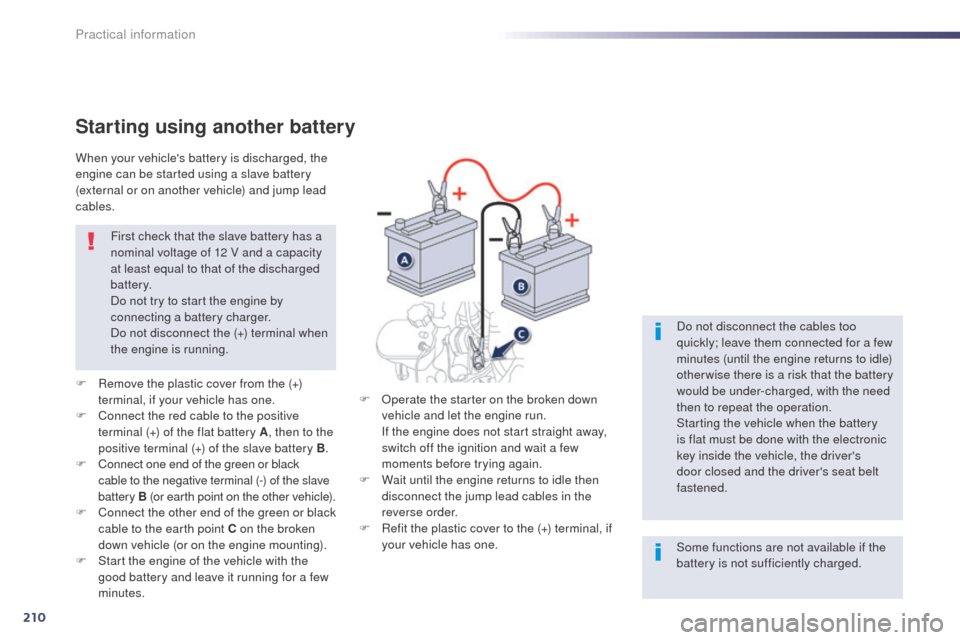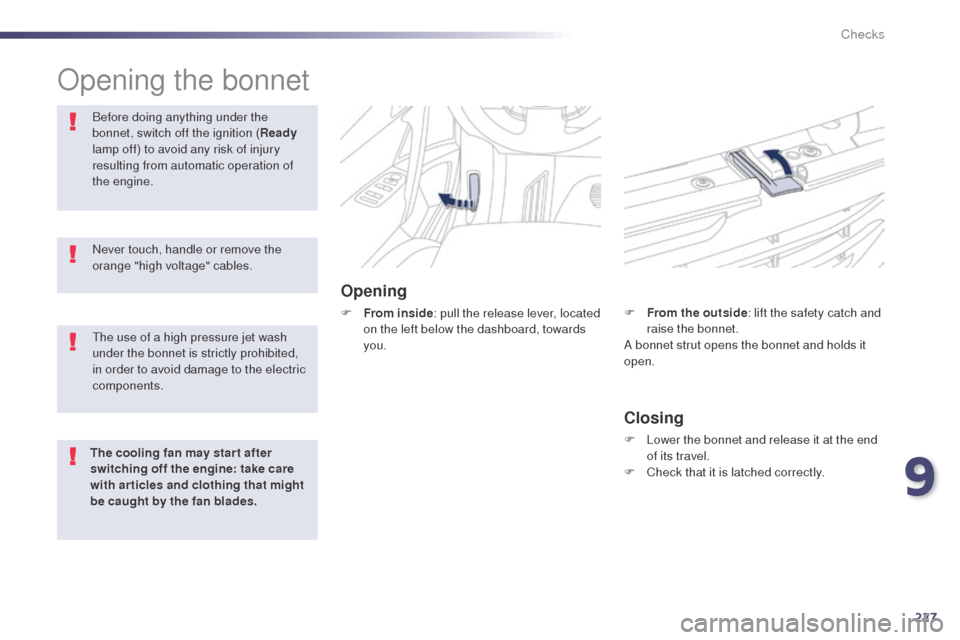2014 Peugeot 508 RXH cables
[x] Cancel search: cablesPage 36 of 338

34
508RXH_en_Chap00c_systeme-hybride_ed01-2014
High voltage
Before doing any work on
the vehicle, switch off the
ignition (Ready lamp off).
High voltage cables
High voltage cables are routed under the
vehicle (sills); take care not to damage them
when the vehicle is used for off-road activity
(such as covering rough ground).
Battery precautions
the high voltage battery must not in any
circumstances be charged from an external
source and must only be handled by a
workshop technician.
th
ere is the risk of serious burns, as well as
electric arcs that could cause serious injury or
even death.
A used Ni-MH (Nickel Metal Hydride) type
high voltage battery must be removed in an
appropriate manner by a repair workshop,
so that its recycling presents no risk to the
environment.
ta
ke care to position lifting equipment
( jack, hoist, ...) at the locations provided
to avoid damaging the cables.
th
e voltage used for the operation of the
electric motor is in the range 150 to 270 Volts.
Be sure to take account of the warning labels
fitted to the vehicle.
ta
ke great care regarding the high voltage and
high temperatures of components carrying the
current.
Emergency cut-off
In the event of an accident, a cut-off system
blocks the high voltage current and cuts off
the fuel pump; your vehicle can no longer be
started.
to r
estart the hybrid system, contact a
P
e
uge
Ot d
ealer.
Never touch, dismantle, remove or
replace the high voltage parts, orange
cables or connectors, even in the event
of an accident.
Hybrid system
Page 195 of 338

193
508RXH_en_Chap08_info-pratiques_ed01-2014
Changing a wheelProcedure for changing a faulty wheel for the spare wheel using the tools provided with the vehicle.
th
e tools are located in the boot, behind the
rear seats.
Access to the tools
List of tools*
3. "Bolt cover" tool. F or removing the bolt protectors (covers)
on alloy wheels.
4.
S
ocket for the security bolts (located in the
glove box).
F
or adapting the wheelbrace to the special
"security" bolts.
5.
O
ne wheel chock for immobilising the
vehicle.
6.
t
o
wing eye.
S
ee "
to
wing the vehicle".
Before doing any work on your vehicle,
switch off the ignition ( Ready lamp off)
to avoid any risk of injury resulting from
automatic operation of the engine.
When using lifting equipment (a jack
for example), take care to use the
jacking points provided, so as to avoid
damaging the high voltage cables.
All of these tools are specific to your vehicle and
can vary according to the level of equipment. Do
not use them for other purposes.
1.
Wheelbrace.
F
or removing the wheel trim and removing
the wheel bolts.
2.
J
ack with integral handle.
F
or raising the vehicle.
* Depending on country of sale.
8
Practical information
Page 212 of 338

210
508RXH_en_Chap08_info-pratiques_ed01-2014
Starting using another battery
F Remove the plastic cover from the (+) terminal, if your vehicle has one.
F
C
onnect the red cable to the positive
terminal (+) of the flat battery A , then to the
positive terminal (+) of the slave battery B.
F
C
onnect one end of the green or black
cable to the negative terminal (-) of the slave
battery B (or earth point on the other vehicle).
F
C
onnect the other end of the green or black
cable to the earth point C on the broken
down vehicle (or on the engine mounting).
F
S
tart the engine of the vehicle with the
good battery and leave it running for a few
minutes. First check that the slave battery has a
nominal voltage of 12 V and a capacity
at least equal to that of the discharged
battery.
Do not try to start the engine by
connecting a battery charger.
Do not disconnect the (+) terminal when
the engine is running.
When your vehicle's battery is discharged, the
engine can be started using a slave battery
(external or on another vehicle) and jump lead
cables.
F O perate the starter on the broken down
vehicle and let the engine run.
I
f the engine does not start straight away,
switch off the ignition and wait a few
moments before trying again.
F
W
ait until the engine returns to idle then
disconnect the jump lead cables in the
reverse order.
F
R
efit the plastic cover to the (+) terminal, if
your vehicle has one. Do not disconnect the cables too
quickly; leave them connected for a few
minutes (until the engine returns to idle)
otherwise there is a risk that the battery
would be under-charged, with the need
then to repeat the operation.
Starting the vehicle when the battery
is flat must be done with the electronic
key inside the vehicle, the driver's
door closed and the driver's seat belt
fastened.
Some functions are not available if the
battery is not sufficiently charged.
Practical information
Page 229 of 338

227
508RXH_en_Chap09_verifications_ed01-2014
Opening the bonnet
Opening
F From inside: pull the release lever, located
on the left below the dashboard, towards
you.
Before doing anything under the
bonnet, switch off the ignition (
Ready
lamp off) to avoid any risk of injury
resulting from automatic operation of
the engine.
Closing
F Lower the bonnet and release it at the end of its travel.
F
C
heck that it is latched correctly.
F
F
rom the outside
: lift the safety catch and
raise the bonnet.
A bonnet strut opens the bonnet and holds it
open.
Never touch, handle or remove the
orange "high voltage" cables.
th
e use of a high pressure jet wash
under the bonnet is strictly prohibited,
in order to avoid damage to the electric
components.
The cooling fan may star t after
switching off the engine: take care
with articles and clothing that might
be caught by the fan blades.
9
Checks
Page 263 of 338

261
04
508RXH_en_Chap11c_SMegplus-i_ed01-2014
CD, MP3 CD / USB player
The audio equipment will only play audio files with ".wma,
.aac, .flac, .ogg and. mp3" file extensions and with a bit rate of
between 32 Kbps and 320 Kbps.
It also supports VBR (Variable Bit Rate) mode.
No other type of file (.mp4, ...) can be played.
WMA files must be of the standard wma 9 type.
t
he sampling rates supported are 11, 22, 44 and 48 KHz.
It is advisable to restrict file names to 20 characters, without using of
special characters (e.g.: " " ? ; ù) to avoid any playing and displ\
aying
problems.
In order to be able to play a recorded CDR or CDRW, when
recording it is preferable to select the ISO 9660 level 1, 2 or Joliet
standard.
If the disc is recorded in another format it may not be played
correctly.
It is recommended that the same recording standard is always used
for an individual disc, with as low a speed as possible (4x maximum)
for optimum sound quality.
In the particular case of a multi-session CD, the Joliet standard is
recommended. Information and advicet he system supports u SB mass storage devices, BlackBerry®
devices or Apple® players via uSB ports. t he adaptor cable not
supplied.
Control of the peripheral device is with the audio system controls.
Other peripherals, not recognised on connection, must be connected
to the auxiliary socket using a Jack cable (not supplied).
Use only USB memory sticks formatted FAT 32 (28-bit file allocation
table).
MUSIC
the system does not support two identical devices connected at the
same time (two memory sticks, two Apple® players) but it is possible
to connect one memory stick and one
Apple® player at the same
time.
It is recommended that official Apple
® uSB cables are used to
ensure correct operation.
Page 321 of 338

319
508RXH_en_Chap12_recherche-visuelle_ed01-2014
Maintenance - technical data
Dimensions 239
Identification markings 2 40
Running out of fuel, Diesel
2
28
Checking levels
23
0-232
-
oil
-
b
rake fluid
-
p
ower steering fluid
-
coolant
-
s
creenwash/headlamp wash fluid
-
D
iesel fuel additive
Checking components
23
3-235
-
1
2 V battery
-
a
ir filter
-
p
assenger compartment filter
-
o
il filter
-
p
article filter
-
gearbox
-
e
lectric parking brake
-
b
rake pads / discs
Changing bulbs 1
99-204
-
front
-
rear 12V battery
2
09 -211
Removing/refitting the 12V batter y
212-215
Load reduction, economy mode
2
16
en
gine compartment fuses
2
05, 208
Opening the bonnet
2
27
un
der the bonnet
2
29
el
ectric motor, Battery
2
36
Diesel engine
2
37 Weights
238
High voltage cables
3
4, 36
.
Visual search